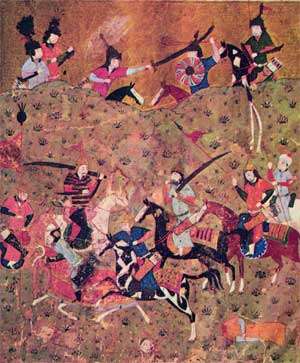Battle of Dandanaqan
The Battle of Dandanaqan was fought in 1040 between the Seljuqs and the Ghaznavid Empire near the city of Merv (present-day Turkmenistan). The battle ended with a Seljuq victory[6] and brought down the Ghaznavid domination in the Khorasan.
| Battle of Dandanaqan | |||||||
|---|---|---|---|---|---|---|---|
| Part of the Seljuk-Ghaznavid Wars | |||||||
 Artwork of the battle of Dandanaqan | |||||||
| |||||||
| Belligerents | |||||||
| Ghaznavid Empire | Seljuk Turks | ||||||
| Commanders and leaders | |||||||
|
Mas'ud I Ali Daya Ahmad Shirazi Abu Sahl Zawzani Abd al-Razzaq Maymandi Begtoghdi Subashi |
Chaghri Tughrul Faramurz[2] | ||||||
| Strength | |||||||
|
50,000 men 60[3] or 12[4] war elephants | 16,000[5] | ||||||
| Casualties and losses | |||||||
| Unknown, likely heavy | Unknown | ||||||
Preparations
When the Seljuq leader Tughrul and his brother Chaghri began raising an army, they were seen as a threat to the Ghaznavid territories. Following the looting of border cities by Seljuq raids, Sultan Mas'ud I (son of Mahmud of Ghazni) decided to expel Seljuqs from his territories.
The battle
During the march of Sultan Mas'ud's army to Sarakhs, the Seljuq raiders harassed the Ghaznavid army with hit-and-run tactics. Seljuq raiders also destroyed the supply lines of Ghaznavids, cutting them off from the nearby water wells. The discipline and morale of the Ghaznavid army dropped seriously. Finally, on May 23, 1040, around 16,000 Seljuk soldiers[5] engaged in battle with an estimated 50,000 Ghaznavid soldiers in Dandanaqan and defeated them, between Merv and Sarakhs.
Aftermath
The Seljuks occupied Khorasan and the cities of the area, encountering little resistance.[7] Tughrul's successful siege of Isfahan in 1050-1051,[8] led to the establishment of the "Great Seljuk Empire". As of Mas'ud's fate after the battle, he initially retreated to India, then was overthrown and later murdered in prison.[9]
Notes
- Grousset, Rene, The Empire of the Steppes: A History of Central Asia , (Rutgers University, 2002), 147.
- Abū Manșūr Farāmarz, C. E. Bosworth, Encyclopaedia Iranica, (July 19, 2011). Archived 2013-11-10 at the Wayback Machine
- Christian, David, A history of Russia, Central Asia, and Mongolia , (Wiley-Blackwell, 1998), 373.
- C.E. Bosworth, The Ghaznavids:994-1040, (Edinburgh University Press, 1963), 115.
- Ann K. S. Lambton (1988). Continuity and Change in Medieval Persia. SUNY Press. pp. 5–. ISBN 978-0-88706-133-2.
- Grousset, Rene, The Empire of the Steppes: A History of Central Asia , (Rutgers University, 2002), 147.
- The Histories of Herat, Jürgen Paul, Iranian Studies, Vol. 33, No. 1/2 Winter - Spring, 2000, 106.
- Tony Jaques, Dictionary of Battles and Sieges: F-O, (Greenwood Publishing Group, 2007), 476.
- Ghaznawids, B. Spuler, The Encyclopedia of Islam, Vol. II, Ed. B.Lewis, C. Pellat and J. Schacht, (Brill, 1991), 1051.
References
- Bosworth, C.E., The Ghaznavids:994-1040, Edinburgh University Press, 1963.
- Christian, David, A History of Russia, Central Asia, and Mongolia , Wiley-Blackwell, 1998.
- Grousset, Rene, The Empire of the Steppes: A History of Central Asia , Rutgers University, 2002.